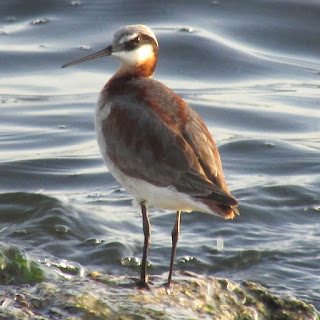Tuesday, June 28, 2016
Saturday, June 25, 2016
Sedge Wren Morning
As previously posted (May 29 below), I missed Sedge Wrens last month at their usual location at Hofma Preserve. But today Roger Newell and I found them at two Muskegon County locations!
Making a "dry run" for our club's July 16 field trip, Roger and I birded four locations. At the old Ferguson Farm on East River Road we found 33 bird species including Wood Duck, Great Blue and Green Heron, Sandhill Crane, American Woodcock (which burst from the trail before we stepped on it), Eastern Phoebe, Great Crested Flycatcher, Eastern Bluebird, Wood Thrush, Field Sparrow, Swamp Sparrow, Indigo Bunting, and several Sedge Wrens including this one on the wet field south of the foot bridge over Little Cedar Creek.
We birded two locations on Holton Duck Lake Road south of River Road, the bridge over the creek and the boat launch at the Muskegon River near the old Walleye Ponds, finding 26 species. We saw a Prothonotary Warbler on the lily pads west of the bridge and a Yellow-throated Vireo in the trees near the boat launch dueting with another west along the river.
We concluded our morning at State Game Area headquarters birding along the Maple River west to the "snipe field". Among the 22 species were Green Heron, Northern Flicker, Pileated Woodpecker, Veery, Indigo Bunting and several Sedge Wrens on the field.
Hopefully the wrens will stick around for our July trip.
- Ric
Thursday, June 23, 2016
July 16 Field Trip Now Posted
Back from Kauai (where "trash birds" were Common Minas, Red Junglefowl, Zebra Doves and Cattle Egrets) I've posted details for the July 16 field trip on our homepage.
- Ric
Tuesday, June 14, 2016
2016 Shorebird Survey - Record Season
Every spring (and again in the fall) since 2004, the Inter-
national Shorebird Survey (ISS) has been conducted at the Muskegon Wastewater System. Per protocol, one census is conducted roughly every ten days from early April to mid June, so this equates to eight sessions, with each lasting 2-3 hours and covering all likely habitat north and south of Apple Avenue. Principal observers have comprised Carolyn Weng and myself; this year, I completed all eight spring surveys.
Spring 2016 proved to be the best in
our long participation with the ISS. Our overall total of 1,349
individual shorebirds of 21 species sets new records for both
number and diversity. The historical spring averages were 561 birds
of 16 species.
mid-April (19th): 94 birds, 8 species
late April (28th): 104 birds, 8 species
late May (27th): 511 birds, 12 species
Plus, mid-May (19th) set a new record
with 294 birds
Nine of the 21 species set or tied
seasonal record totals (noted in the final table). Plus, seven
species established new one-day records:
Greater Yellowlegs - 28 on April 19;
previous daily record 28
Lesser Yellowlegs - 44 on May 6;
previous daily record 39
Stilt Sandpiper - 1 on May 27; ties
previous daily record
Sanderling - 3 on May 27; ties previous
daily record
Least Sandpiper - 77 on May 19;
previous daily record 51
Semipalmated Sandpiper
- 383 on May 27; previous daily record 32
Wilson's Snipe - 8 on April 19;
previous daily record 2
Here are the full results, with this
year's grand totals and past historical averages:
Black-bellied Plover - 1; mean 2.3
Semipalmated Plover - 34; mean 7.5
Killdeer - 154; mean 127.9
Spotted Sandpiper - 232; mean 128.1;
previous record 207
Solitary Sandpiper - 1; mean 0.7
Greater Yellowlegs - 40; mean 6.1;
previous record 22
Willet - 1; mean 2.9
Lesser Yellowlegs - 114; mean 32.7;
previous record 81
Upland Sandpiper - 29; mean 16.7;
previous record 28
Ruddy Turnstone - 1; mean 5.0
Stilt Sandpiper - 1; mean 0.3; ties
previous record
Sanderling - 3; mean 0.9; ties previous
record
Dunlin - 101; mean 88.8
Least Sandpiper - 83; mean 34.1;
previous record 65
White-rumped Sandpiper - 10; mean 10.5
Pectoral Sandpiper - 38; mean 8.2
Semipalmated Sandpiper - 491; mean
77.9; previous record 169
Short-billed Dowitcher - 1; mean 3.4
Wilson's Snipe - 8; mean 0.8; previous
record 2
Wilson's Phalarope - 5; mean 3.3
Red-necked Phalarope - 1; mean 0.3
Of the 21 species encountered this
spring, 16 exceeded historical norms. Five dropped below average, but
aside from White-rumped Sandpiper, these were uncommon species whose
long-term means can be skewed by one exceptional year. Counts of
Semipalmated Plover, Greater Yellowlegs, Pectoral Sandpiper,
Semipalmated Sandpiper, and Wilson's Snipe all exceeded previous
averages by an amazing factor of four or more. Semipalmated
Sandpipers were especially noteworthy; counts of 28 on June 11 and,
especially, 383 on May 27 were outstanding.
Photos: Upland Sandpiper, Wilson's Phalarope, White-rumped Sandpiper, Semipalmated Sandpiper.
- Brian Johnson
Photos: Upland Sandpiper, Wilson's Phalarope, White-rumped Sandpiper, Semipalmated Sandpiper.
- Brian Johnson
Sunday, June 12, 2016
Strange Behavior
My wife Carol saw this Northern Harrier land in a corn field. It looked like it was eating something. I got the scope out and turned it up to 60X and could see the Harrier was eating an egg. Has anyone else seen this behavior?
Midland Clubtail dragonfly (I think)
eating an American Copper butterfly.
eating an American Copper butterfly.
- Charlie DeWitt
Sunday, June 5, 2016
Muskegon Wastewater Sunday
Grasshopper Sparrow
Bobolink
Dickcissel
I made a quick trip to the Muskegon County Wastewater looking for Bobolink (#193) and Dickcissel (#194) for my two-county list.
They were in the RI cells, Bobolink in C10 and Dickcissel in D9.
- Charlie DeWitt
Subscribe to:
Posts (Atom)










